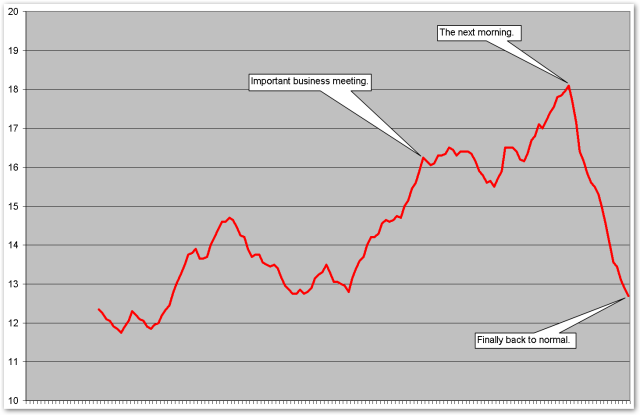I think this one image tells a great story. It presents new data and it presents it in a way we haven't seen before on my blog.

The data span four days. At the beginning of the data series in the chart above, we see that my eye pressure is around 13. We see some variation due to time of day and other factors. Then, as the important afternoon business meeting approaches, my eye pressure rises to a new high level. Then we see the post-meeting effects in my high eye pressure the next morning. Finally, late the next day, my eye pressure returns to the levels I typically see.
There are 162 eye pressure measurements recorded in this graph. All the data is for my right eye. I took an average of 40 eye pressure measurements on each of these four days. The line in the chart represents a 20-period moving average.
During this period there was no change in medication or any other factor. The only variable factor I can identify was the business meeting.
The above data shows that even after the stressful event was over, my eye pressure remained elevated for about 24 more hours. The business meeting concluded successfully. We reached an agreement and everyone was very happy. I was completely relaxed afterwards. My eye pressure didn't normalize until late the following day (which is today).
This chart shows how easily we could be mislead if we took just a few eye pressure measurements. For example, if I had measured my eye pressure just once before the meeting (during the time when I felt stressed), and then once soon after the meeting (when I felt relaxed), I could easily have concluded that my eye pressure was low while stressed and high while relaxed. This would be a false conclusion. With 162 measurements instead of just 2 and with the data extending over four days, we see a much more complete and accurate picture.
The maximum eye pressure value I recorded the morning after the meeting was higher than any single reading this whole year with the exception of one - and that one was during a period where I experimented with a change in my medication administration. I think that fact helps highlight the extent to which a single finite stressor can have continuing detrimental effects.
At no point during these four days did I really feel stressed. Does that surprise you? I mention this to illustrate that the stressor event that elevates eye pressure doesn't have to be something that makes us feel stressed out or makes us experience a strong negative emotion. Our subjective feeling of stress can be much more subtle and the relationship between stress and eye pressure will still show up. The feelings can so subtle that one might easily overlook them. (As I said, I didn't really feel stressed about this business meeting.) Yet the challenge event can still provoke the kind of eye pressure response shown in the chart above. This is good news for researchers because it shows that they don't have to rely on subjective assessments of stress. The relationship between stress and eye pressure can be demonstrated simply by having subjects perform a certain task designed by psychologists to be "stressful". Even if that task is far from being as stressful as things we sometimes encounter in real life, it can still elicit the type of elevated eye pressure reaction shown above. I think this allows for great research opportunities.
The lesson: stress management is one of the most important skills we glaucoma patients can acquire. Speaking from personal experience, I can say that even if you don't feel like you have a problem with stress in your life, if you have primary open angle glaucoma (or one of its closely related forms), you will be doing yourself a great favor by looking deeply at your subtle emotions and investing some of your time in creating additional inner peace and tranquility.
Filed Under (tags):
- dave's blog
- Log in or register to post comments

